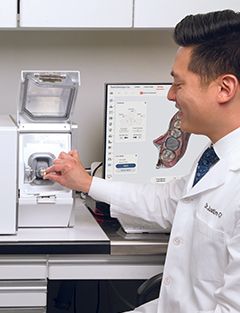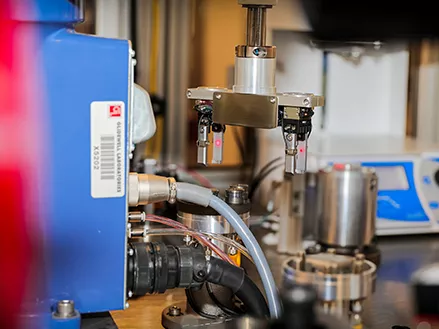Glidewell is doubling down on AI, automation, robotics and workflow digitization as it charts the future of lab tech—but the pandemic has also reinforced the importance of connection, craftsmanship and collaboration with customers.

AS A DENTAL technology company with roots in the analog 1970s, Glidewell occupies a unique niche in the large-scale lab business. Rather than turning to third parties, it has leveraged its own approach to innovation to develop proprietary solutions for better products. It has also trickled those advances down into milling products for in-office use. Five decades and more than 40 U.S. patents later, Incisal Edge spoke to Glidewell’s chief technology officer, Mike Selberis, and Dzevad Ceranic, its executive vice president of laboratories operations, about the last year—and what lies ahead.
On adapting to customers’ changing needs: Simply being there for doctors is more important than ever since the pandemic. According to Ceranic, labs today need to “help solve real problems in [customers’] practices,” and the more they can be a resource, the more valuable they’ll be. “Just being available during these difficult times” is as important as the product, he adds.
On how AI is mitigating the effects of today’s strained labor market: Both Selberis and Ceranic say “more, better, faster” has long been an overriding R&D driver for Glidewell. However, that has been more vital than ever as customers continued recovering from the pandemic. “AI-generated designs are cutting time and cost while making employees more efficient,” Selberis says. Their data show “we’re delivering restorations that result in lower remakes, less seating time for the doctor, and faster, more consistent turnaround times.” Adds Ceranic, “This marriage of human intelligence with machine intelligence will benefit both doctor and patient.”
On Glidewell’s vertical integration of tech: Digitized workflows are becoming the rule rather than the exception with most labs. Selberis says an important point of differentiation for Glidewell is “developing purpose-built solutions tuned to [our] customers’ needs.” Which is why Glidewell relies on custom software and automation designed specifically for their workflows. Selberis points to AI, robotics and additive manufacturing as keys to “delivering restorations at scale for labs that embrace change and adoption of new technologies.”

Lab masters: (From top) Dr. Justin Chi, Glidewell’s director of clinical technologies; robotics at work in the company’s crownmaking facility.
On continuous improvement: Unsurprisingly, Ceranic and Selberis are passionate about process and quick to delve into its wonkier aspects. In addition to employing a team of “black belts” who work directly with labs, Glidewell breaks down top measurements in the form of cascading metrics, linking them throughout the organization. But the duo also use what they call “meaningful” key performance indicators with their team so they understand, as people, how they contribute to the businesses’s success.
On what’s coming next: As the evolution of digital workflows dovetails with advances in materials and technology, Ceranic says it’s important from a customer perspective to stay focused on how they work together. “Patient, practice and lab [should be] seamlessly joined and integrated through applications, services and lab processes.”




